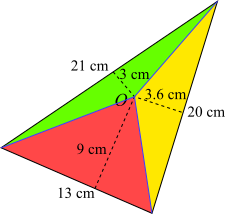Skip over navigation

Or search by topic
Number and algebra
Geometry and measure
Probability and statistics
Working mathematically
Advanced mathematics
For younger learners
Scalene Area
Age 11 to 14
ShortChallenge Level 





- Problem
- Solutions
Drawing lines from O to each vertex
Drawing lines from O to each vertex splits the triangle into three smaller triangles, as shown below.

For each smaller triangle, the 'base' and 'height' are shown (the 'bases' are the sides of the original triangle, which are not horizontal). So, using Area $=\dfrac{1}{2}$ base$\times$height, the areas of the smaller triangles can be found:
Red triangle area $\dfrac{1}{2}\times13\times9$
Yellow triangle area $\dfrac{1}{2}\times20\times3.6$
Green triangle area $\dfrac{1}{2}\times21\times3$
So the total area of the triangle is
$\dfrac{13\times9+20\times3.6+21\times3}{2}=\dfrac{117+72+63}{2}=126$cm$^2$
Using trigonometry
The cosine rule can be used to find one of the angles in the triangle, and then the formula $\frac{1}{2}ab\sin{C}$ can be used to find the area.
For example, the angle between the 13 cm side and the 20 cm side can be found using the cosine rule:$$\begin{align}&21^2=13^2+20^2-2\times 13\times20\times\cos{\theta}\\\Rightarrow&441=569-520\cos{\theta}\\\Rightarrow&\cos{\theta}=\frac{569-441}{520}=\frac{128}{5200}=\frac{16}{65}\\\Rightarrow&\theta=75.75^{\text{o}}\end{align}$$
So the area of the triangle is $\frac{1}{2}\times13\times20\times\sin{75.75^{\text{o}}}=126$ cm$^2$.
Using Heron's Forumla
Heron's formula for the area of a triangle with sides $a$, $b$ and $c$ is $\sqrt{s(s-a)(s-b)(s-c)}$, where $s$ is half of the perimeter of the triangle.
For this triangle, $a$, $b$ and $c$ are $13$, $20$ and $21$, and the perimeter is $54$, so $s=27$.
So the area is $$\begin{split}\sqrt{27\times14\times7\times6}&=\sqrt{3^3\times2\times7\times2\times3}\\&=\sqrt{2\times2\times3^2\times3^2\times7\times7}\\&=\sqrt{(2\times3^2\times7)^2}\\&=2\times3^2\times7\\&=126\end{split}$$
So the area is $126$ cm$^2$.
Drawing lines from O to each vertex splits the triangle into three smaller triangles, as shown below.

For each smaller triangle, the 'base' and 'height' are shown (the 'bases' are the sides of the original triangle, which are not horizontal). So, using Area $=\dfrac{1}{2}$ base$\times$height, the areas of the smaller triangles can be found:
Red triangle area $\dfrac{1}{2}\times13\times9$
Yellow triangle area $\dfrac{1}{2}\times20\times3.6$
Green triangle area $\dfrac{1}{2}\times21\times3$
So the total area of the triangle is
$\dfrac{13\times9+20\times3.6+21\times3}{2}=\dfrac{117+72+63}{2}=126$cm$^2$
Using trigonometry
The cosine rule can be used to find one of the angles in the triangle, and then the formula $\frac{1}{2}ab\sin{C}$ can be used to find the area.
For example, the angle between the 13 cm side and the 20 cm side can be found using the cosine rule:$$\begin{align}&21^2=13^2+20^2-2\times 13\times20\times\cos{\theta}\\\Rightarrow&441=569-520\cos{\theta}\\\Rightarrow&\cos{\theta}=\frac{569-441}{520}=\frac{128}{5200}=\frac{16}{65}\\\Rightarrow&\theta=75.75^{\text{o}}\end{align}$$
So the area of the triangle is $\frac{1}{2}\times13\times20\times\sin{75.75^{\text{o}}}=126$ cm$^2$.
Using Heron's Forumla
Heron's formula for the area of a triangle with sides $a$, $b$ and $c$ is $\sqrt{s(s-a)(s-b)(s-c)}$, where $s$ is half of the perimeter of the triangle.
For this triangle, $a$, $b$ and $c$ are $13$, $20$ and $21$, and the perimeter is $54$, so $s=27$.
So the area is $$\begin{split}\sqrt{27\times14\times7\times6}&=\sqrt{3^3\times2\times7\times2\times3}\\&=\sqrt{2\times2\times3^2\times3^2\times7\times7}\\&=\sqrt{(2\times3^2\times7)^2}\\&=2\times3^2\times7\\&=126\end{split}$$
So the area is $126$ cm$^2$.
You can find more short problems, arranged by curriculum topic, in our short problems collection.
You may also like
Hallway Borders
What are the possible dimensions of a rectangular hallway if the number of tiles around the perimeter is exactly half the total number of tiles?

